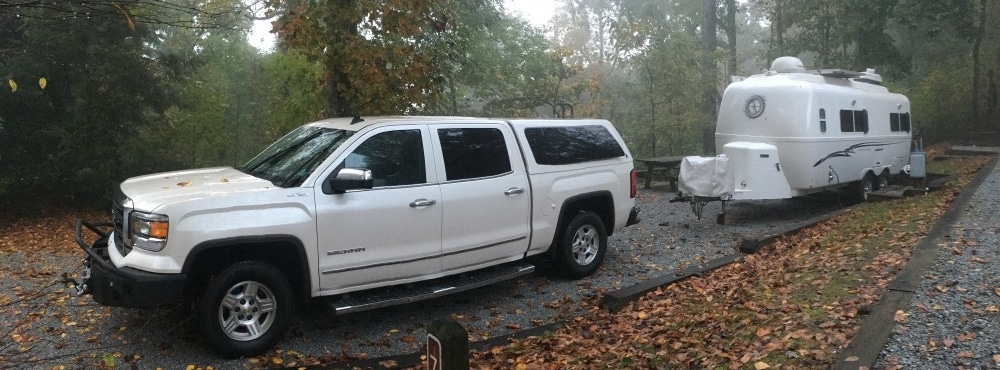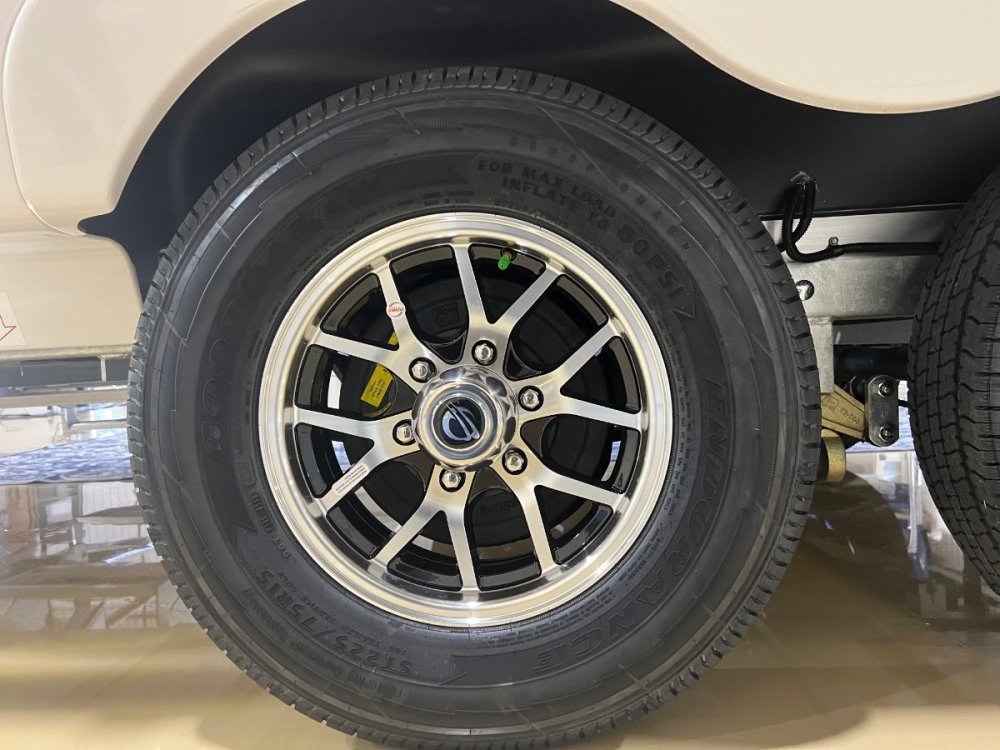-
Posts
3,287 -
Joined
-
Last visited
-
Days Won
169
Everything posted by ScubaRx
-
This is correct.
-
John, the new wheels will still be 6 bolt on 5.5”.
-
I took this photo this morning of one of the Elite II’s on the showroom floor. Rodney says this is the tires and wheel’s they will be using on the 2023 models. He did say that their existing stock of 16” wheels and tires will be used first. So, it may be as late as March of ‘23 before the new models will start to be delivered with the new sets.
-
The axles are not changing. The are no parts available to convert the 3500 pound axles used on the Elite II from drum to disc. It would be possible on the Elite I since it is supplied with a 5200 pound axle.
-
Fifteen years ago, 16” wheels were used extensively by the automotive industry. Now it’s an oddball size. All the heavy duty trucks are using 18” or 20”. Also at that time you could not buy a heavy duty tire in a 15” size and the ST tire’s being made were all Chinese maypops.
-
Actually, Michelin quit making the tire they were using. Is your trailer still on the market? This is a non issue for current owners.
-
We are spending the night at Oliver National Park tonight. We took Anita out to lunch and had dinner tonight with Phil and two of the lovely ladies in his life. Phoenix is adorable as expected. I found out several weeks ago that Oliver had made (what I consider) a major change that will be included in the 2023 models. Today I sat down with some management folks to get the lowdown. As many of you probably know, Goodyear has bought Cooper Tire. Oliver has equipped their new trailers with Coopers for the past few years. Due to the immediate unavailability of the tires they have been using, their only choice was to switch tire companies. During their research they reassessed their needs and goals for running gear. The decision has been made that going forward and starting immediately, both Oliver models will be equipped with 15 inch wheels and tires with a matching spare. The tires will be Goodyear Endurance ST225/75-15’s. Tire SizeST225/75R15 Product Code724857519 Speed RatingN Load Index117 Load RangeE SidewallBlack Uniform Tire Quality Grade (UTQG)- Max Load (lbs)2830 Max Inflation Pressure (PSI)80 Approved Rim Width (in.)6.0-7.0 Measured Rim Width (in.)6.0 Section Width (in.)8.8 Tread Depth (in 32nds)8 Outside Diameter (in.)28.3
- 79 replies
-
- 12
-

-

-

-
Although I wouldn’t do it, if you want to go cheaper than lithiums, you could just go to AGM’s. But for less than $3K, you can replace the four T-105’s with 3x100 amp hour Battle Born lithium batteries and a new PD charger that’s plug and play. There’s no need to spend $15K. And you’ll end with an extra 100 amp hours over what you currently have.
- 34 replies
-
- 10
-

-
I just replaced mine, you’ll need four for an Elite II. Monroe Shocks & Struts Magnum RV 555001 Shock AbsorberMonroe Shocks & Struts Magnum RV 555001 Shock Absorber https://www.amazon.com/Monroe-555001-Gas-Magnum-Shock-Absorber/dp/B000C53RR6/ref=sxts_rp_s_a_1_0?content-id=amzn1.sym.fcbf2b35-b342-496e-87b6-d95b51fd1abd%3Aamzn1.sym.fcbf2b35-b342-496e-87b6-d95b51fd1abd&crid=2RJE8U8YPP2GL&cv_ct_cx=555001+monroe&keywords=555001+monroe&pd_rd_i=B000C53RR6&pd_rd_r=90e48016-e3ee-4551-8ce8-0e8b1fed491a&pd_rd_w=2UL1u&pd_rd_wg=OtqDu&pf_rd_p=fcbf2b35-b342-496e-87b6-d95b51fd1abd&pf_rd_r=R6AR2HNZZ3W4CKAD4NZ9&psc=1&qid=1665797842&qu=eyJxc2MiOiIwLjU5IiwicXNhIjoiMC4zMCIsInFzcCI6IjAuMDAifQ%3D%3D&sprefix=555001%2Caps%2C353&sr=1-1-ea136695-3596-4534-80e7-1570345d02b9
-
Haiduk, the solo project of Luka Milojica is an unrelenting, hypnotic force that greets listeners with a barrage of death-infused black metal that is prominently displayed on the latest release “Diabolica”, which was released in September last year. Yeah, not my cup of tea either.
-

Have I killed our Blue Sky Energy MPPT PV charge controller?
ScubaRx replied to MAG's topic in Mechanical & Technical Tips
I believe that was supposed to be “plastic bag”. Or just wrap the positive (red) wire’s terminal with electrical tape to prevent it from inadvertently touching something that’s grounded and releasing the white smoke. -
John, I applaud your approach to purchases. I don’t think we’ve yet had the pleasure of actually meeting each other. But those that know me and have seen our truck, probably recognized the tongue in cheek sarcasm of my post. When we meet, you’ll see what I mean.
-
I like that solution. Simple, easy, cheap and quick.
-

Have I killed our Blue Sky Energy MPPT PV charge controller?
ScubaRx replied to MAG's topic in Mechanical & Technical Tips
For everyone posting at this point, please go back and read the entire thread to get you up to speed on what has happened so far. Definitely do not leave the batteries in the tray. -
I never buy anything that I don’t absolutely, positively think that I MAY use one of these days.
-

Anyone else watch the Tesla Cybertruck launch?
ScubaRx replied to SeaDawg's topic in Towing an Oliver
I think what we really need are EV’s pulling travel trailers that are self-powered. If the EV’s were also self-driving, equipped with 360 degree 8K cameras and connected to the internet via satellite uplinks we could preprogram our route into the nav system and just stay home and watch the trip on our phones. -
We towed our 2008 Elite 60-70K miles. We always ran our tires at 80 psi because that’s what Jim Oliver told me to do. I now know a hell of a lot more about towing. The tires on our Elite II are 12 ply all steel belted and have a maximum tire inflation rating of 95 psi to 110 psi and that would be fine if our Oliver weighed 12,000 pounds. Fortunately, despite the fact that she’s a big ole gal, at “only” about 7000 pounds I can safely run them at 60-65psi, which I do. Now, that’s for highway use. Only. If you head up something like a rough forest service road or, heaven forbid, decide to drive the 70 miles of washboard into Chaco Canyon or the 27 miles of very bad road out to the Racetrack Playa in Death Valley then please stop and air down. Obviously, you’ll need the ability to re-inflate when you get back to the pavement, so a good compressor and tire gauge is imperative. If you are unable or unwilling to do this, then just don’t go. Ignore this at your own peril. If you do, you’ll be tightening, repairing and replacing plumbing, electrical and mechanical stuff for a while. And some of this will be before you even get home. I’ll leave it to your imagination to figure out why I mention these things.
-
You would actually cut the weight by almost 100 pounds.
-

Tire pressure confusion - Legacy Elite 2 POLL
ScubaRx replied to John E Davies's topic in Towing an Oliver
I think you may be on to something here. Because Mars is half again further from the sun than Earth, may explain why our tires run cooler there. Seems reasonable… -
Up to around 150 continuous amps, a single 100 amp hour LiFePO4 battery can take all the current you can throw at it. The PD chargers in our Oliver’s put out 45-60 amps depending on how old your trailer is. The limiting factor here is the wire size going from the charger to the batteries. You can’t necessarily just add a higher output charger without considering the wiring too. The Xantrex 3000 watt inverter/charger has a maximum 150 amp output. FYI: AGM batteries should not be charged at a rate greater than 25% of their stated battery capacity. The battery capacity is indicated by Ah (amp hour).
-
Battle Born's reliable, safe, and non-toxic LiFePO4 batteries last 10x longer than lead acid. Probably correct, I believe this to be true. They are 1/5th the weight for the same amount of usable power. Correct as written, but a lithium battery will still weigh 1/2 of what a similarly sized lead acid will weigh. They charge 5x faster. They CAN charge 5x faster IF you have a charger that can put out 5x the amps of what you currently have. require zero maintenance. NOTHING requires ZERO maintenance. and are backed by an industry-leading 10 year warranty. True…
-
This is how the current situation got started. Years ago, Oliver’s sales manager asked me to come up with a design for a bike rack. I did and they built a good 2” rack that could handle any two bikes. They informed all buyers of the rack its weight limitations and even had a sticker stating that information proudly displayed on each rack. Oliver built a bunch of these units with my design but ultimately changed it to the current rack first with a 2” receiver then moving down to a 1-1/4” receiver due to “the incident.” Much like the general population, there are a few owners that don’t necessarily read and follow directions. One owner didn’t. He bought one of the racks with the 2” receiver and, although I don’t know exactly what happened, I can imagine him installing one of those flat racks you see hanging off the tail end of a vehicle. He probably loaded a cooler of ice and beer on one end and a plastic tote of whatever beside it, put a coupe of bungees around it and called it good. Somewhere along his way everything proceeds to turn to shite. He complains to Oliver that his expensive rack didn’t meet his expectations, they wonder how it failed if it hadn’t been overloaded, he swears it couldn’t have been, one thing leads to another and here we are… I’ll be happy to share my design with anyone. Although I don’t carry bikes on it, I’ve used it on the rear of our Hull #050 many times carrying upwards of 200 pounds. I’ve never had an issue with it.
-
The Haunted Campground
-
Good idea!



